The Skill Of Curating A Crowd

I recently read Paris Hilton’s great book, Paris: The Memoir right now. One of the points Paris makes is that being great at parties is not just about hanging out and looking pretty – it’s also about the skill of curating a crowd. While curating a crowd can involve carefully selecting and organizing a group of individuals with similar interests, goals, or values, it can also involve continued curation of small groups once that group is put together. Here are some thoughts on honing the skill of curating a crowd:
- We need to clearly define the purpose: Determine the purpose or objective of curating the group. Are we organizing an event, starting a community, or fostering collaboration? Clearly defining the purpose helps us to curate a group that aligns with our goals.
- Identify your target audience: Understand who you want to attract and engage with. Consider demographics, interests, expertise, and any specific criteria that are relevant your purpose. This will help ensure that the crowd you curate is focused and aligned.
- Create engaging content: Develop content and activities that resonate with your target audience. This could include interesting topics, workshops, discussions, or interactive sessions. Tailoring your offerings to their needs and interests will encourage participation and build a sense of community.
- Foster communication and collaboration: Encourage open dialogue and facilitate connections among the crowd members. Provide platforms or forums where individuals can interact, exchange ideas, learn from one another, and collaborate on projects or initiatives.
- Maintain a positive and inclusive environment: Create a safe and welcoming space where everyone feels valued and respected. Promote inclusivity by actively listening to diverse perspectives and promoting equal participation. Address any conflicts or issues that may arise promptly and fairly.
- Continuously evaluate and improve: Regularly assess the effectiveness of your curation efforts. Seek feedback from participants and make adjustments as needed. Pay attention to the needs and evolving interests of the crowd, and adapt your approach accordingly.
Remember, curating a crowd is about creating an environment where individuals can connect, learn, and thrive together. By focusing on their needs and fostering a sense of belonging, we can create a vibrant and engaged learning community.
The Inner Ring Phenomenon

C.S. Lewis wrote about inner circles in “The Inner Ring.” I would encourage you to read it. In the “The Inner Ring” was the Memorial Lecture he gave at King’s College London, in 1944. In this lecture Lewis explored the desire to belong and be accepted by an exclusive group (inner circle) and how it can affect individuals. Lewis warned, “The circle cannot have from within the charm it had from outside. By the very act of admitting you it has lost its magic. Once the first novelty is worn off the members of this circle will be no more interesting than your old friends. Why should they be? You were not looking for virtue or kindness or loyalty or humor or learning or wit or any of the things that can be really enjoyed. You merely wanted to be “in.” And that is a pleasure that cannot last. As soon as your new associates have been staled to you by
custom, you will be looking for another Ring.” Here, Lewis was suggesting that being part of an exclusive inner circle will lose its allure once we are actually inside it. The charm and allure come from the perception and longing to be a part of that particular group, but once we are on the inside, we may realize that it is not as special as it seemed. In other words, the exclusivity itself may not provide the satisfaction or fulfillment that one might expect.
Lewis used the metaphor of the onion in “The Inner Ring.” He posited that the inner ring is like peeling an onion – once you have succeeded, there is nothing left. I am going to guess you are all like me and have been parts of inner circles. Additionally, I would guess we have all worked in environments with a distinct inner circle we were not a part of. I have worked for two organizations that had/still have distinct inner rings that I was not invited into. Nor, were most of the others really doing the work. It’s toxic to a great collaborative work community. Especially when the top, hierarchically speaking, person is the ring leader (pun intended). This also, as you well know, in our government and law-making circles (again, pun intended).
“Sweet is a legacy, and passing sweet
Lord Byron quoted by C. S. Lewis in “The Inner Ring”
The unexpected death of some old lady.” ~ Lord Byron
While Lewis acknowledges that being part of an inner circle is not inherently bad, there can be negative aspects associated with it. Wanting to get into an inner circle can can lead to being seen as exclusionary. The negative in some situations is that the inner ring can lead to the formation of cliques, or other exclusionary, behavior which can and create feelings of create isolation an and rejection unhealthy sense for those who of are not included. Additionally, seeking validation among the group or self-worth members. solely from Inner rings can also perpetuate an exclusive inequality and favoritism group that is unhealthy and limiting personal growth for those both in and outside the ring. An inner circle can shut out others who may have valuable perspectives and contributions to offer. It’s important to foster inclusivity and recognize that meaningful connections should be formed outside an inner ring.
I close with the recognition that it is in our very nature to desire being in the inner ring. Lewis told us, “…at all periods between infancy and
extreme old age, one of the most dominant elements is the desire to be inside the local Ring and the terror of being left outside.” We just need to remember it is never as satisfying on the inside as it looked from the outside and is terrifying when we realize we are no longer on the inside.
I Am Mad That I Liked It
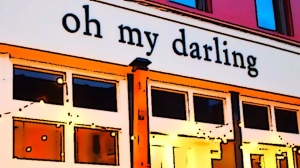
This week, while in Syracuse, New York, our Harvard Center for Education Policy Research National Center for Rural Education Research Networks team went to eat dinner at the great restaurant Oh My Darling. For dessert we had Beignets – WONDERFUL! Our server told us we would get chocolate and caramel sauces and lemon curd to dip our Beignets in. She also told us that mixing the chocolate and caramel together was wonderful – and it was! When we were done there was one Beignet left and I just couldn’t let it go to waste. So, I tried mixing the lemon curd and caramel together and it was delightful – really, better than the chocolate/caramel combination. I immediately had others at the table try the combination and they concurred. I shared the new combination with our server and she turned up her nose. She said, “There is no way that is better than the chocolate and caramel combo.” Immediately, someone on the team chimed in and backed me up and said, “Yes it is.” The challenge was on!
Our server then proceeded back to the kitchen to have them make her a single Beignet so she could try the new combination of Caramel and Lemon Curd to dip her Beignet in. We were ready to leave but waited with anticipation for our server to get back and report her taste testing results. What happened when she returned is why I am telling this story by writing this post. She returned with a smile on her face and said, “I am mad that I liked it.” This statement really intrigued me. I asked, “What do you mean by that?” Our server then stated, “It means that I am feeling conflicted or frustrated about enjoying something that I expected not to like.” She had found something, on my recommendation that went against her usual preferences or beliefs, but still found herself enjoying it. It was a playful way of expressing surprise or annoyance at her own enjoyment.
The way our server expressed her surprise or frustration at enjoying something unexpected had a profound effect on me. I kept asking everyone in our group, “Have you ever been mad that you liked something?” This is a pretty good prompt and I encourage you to contemplate the question. Of course, I had to do a little research on this and the feelings our server was having is an actual psychological thing. It’s called “dimorphous expressions,” or expressions of emotion that seem at odds with what a person is actually feeling. Interesting, right?
Oriana Aragón, an assistant professor of marketing at Clemson University and Yale Psychology Professor John Bargh studied why we have contradictory expressions. It seems that discovering something new that we like a lot can throw us off our game, causing a mix of emotions. You can probably think of times when this has happened to you. I know I can. I’m thinking of those simple times when someone wants us to try a food we’ve never tried and we say no, just knowing we weren’t going to like it. We might just miss out on something we really enjoy.
For me, this was a reminder to resist being skeptical or resistance to trying something new just because we don’t think it will work or be good. I’m thinking about things that aren’t just food here. It could be a new product idea, new technology to use, new vacation spot, or new idea for delivering content to those we serve. This experience was another huge reminder to use our curiosity and take risks. We won’t know if we don’t try. We won’t know if we aren’t open to others’ opinions, ideas, and experiences. As my favorite quote from an unknown author goes, “To argue with someone else’s experience of reality is futile…To add their experience to yours is possibly useful.” What are you ready to be mad that you like?
Curiosity and Creative Conflict
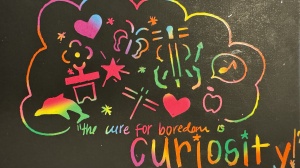
I was reminded in one of my teacher leader gatherings a couple of weeks ago how important making space for curiosity is in education. One of the teachers made a scratch art stating, “The cure for boredom is curiosity” (See featured photo)! I would add to this that we need to also be teaching and modeling how to have creative conflict. Right now in the University of Oxford class I am taking we are learning how important encouraging and navigating creative conflict is to professional service firms, like mine. Therefore we should be helping our students understand creative conflict for their leadership development. It would be highly beneficial for their personal and professional growth. It helps our students develop important skills such as critical thinking, problem-solving, effective communication, and collaboration.
To teach creative conflict effectively, educators can follow these guidelines:
- Create a safe and inclusive learning environment: open and respectful dialogue where the students are in a psychologically safe space.
- Model and teach active listening: Help students to listen to understand by starting with empathy.
- Foster a growth mindset: Conflict is an opportunity for growth and learning. Conflict provides the chance for exploring different viewpoints and find innovative solutions.
- Practice constructive communication strategies: Provide the ethos where students can express their opinions clearly and respectfully, using “I” statements. Focusing on the issues or problem instead of attacking individuals must also be modeled and practiced.
- Provide opportunities for group work and collaboration. This will provide students with real-world practice resolving conflicts creatively.
- Help students develop self-awareness in order to become more open-minded and adaptable.
- Develop space for discussions and debates of real-world issues and problems: Students need to explore diverse perspectives and challenge their own beliefs.
- Model creative conflict for students.
Let’s all help our young people to foster creative conflict by promoting healthy and respectful disagreements that lead to innovation and growth, rather than destructive arguments. Think how much better the world would be if we were all better at this!
Polyphonic Leadership

In my University of Oxford class I’m in right now we have been using an orchestra metaphor through line to discuss orchestral leadership. While reviewing some literature I came across the musical term “polyphonic”, which means a musical texture comprised of two or more independent melodies or voices which combine to form one piece of music. The term “polyphonic” can also be used to describe a leadership style that encourages the inclusion and involvement of multiple perspectives, voices, and ideas.
A polyphonic leader values collaboration and diversity of thought, allowing different individuals and teams to contribute their unique insights and expertise. This approach recognizes that no one person has all the answers and that collective intelligence and the synergy created by multiple voices can lead to more innovative solutions and better decision-making. Polyphonic leadership fosters an inclusive and empowering environment where everyone’s contributions are valued and respected, leading to higher employee engagement and overall organizational success.
In contrast to the polyphonic style of leadership would be the monophonic leader. This is a very hierarchical style with an autocratic leader and relies solely on the perspective and opinions of one individual. This can lead to a lack of diverse ideas and a narrow focus on one person’s strengths and weaknesses. It may also create an environment where employees feel their contributions are not valued or heard. Monophonic leadership can hinder innovation, hinder collaboration, and ultimately hinder overall organizational success.
Polyphonic leadership is in sync with constructivist theory, which I subscribe to in education, because it promotes the idea that knowledge and meaning are constructed through collaborative and inclusive processes. Constructivist theory emphasizes the active participation of individuals in creating their own understanding of the world, and polyphonic leadership aligns with this by valuing diverse perspectives and encouraging open dialogue and collaboration among team members. We need to help all those we serve tap into the collective intelligence and creativity of their team members.
A Might Be

In the book Perelandra by C.S. Lewis, the phrase “A might be” really intrigued me. The protagonist in the book, Elwin Ransom, represented the human perspective and was referring to the concept of potentiality or what could possibly be. It reflected the idea that everything in existence has the potential to become something else or to undergo change. It suggests that there are endless possibilities and potential outcomes in the universe.

I do believe we have endless possibilities and potential. As humans, it is our role and responsibility to explore and discover those possibilities and potential outcomes. We have the ability to think, reason, and make choices, which gives us the power to help shape all that goes on around us. It is up to us to use our potential wisely and make decisions that not only benefit ourselves but also contribute to the greater good of humanity and the universe as a whole. What might be?
The Unlearning Leader

Those of you who regularly read my blog know I am taking courses at the University of Oxford Saïd Business School. Yesterday the question of ‘“What are the things I need to start and what are the things I need to stop?” was posed. This is a very meaningful prompt to contemplate. It was then discussed that “Failing to unlearn runs the risk that new responsibilities and demands will be layered onto existing ones; nothing is ever discarded and work becomes overwhelming” (2023, Saïd Business School). This really hit home in the policymaking side of my life in education. As we consider redesigning high school or anything in education, we have a lot of things to unlearn.
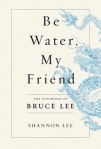
Then I thought back to some teachings of Bruce Lee. I recently read Be Water, My Friend: The Teachings of Bruce Lee by Shannon Lee. Bruce Lee believed that “the value of a vessel – whether a cup, pot, or bottle – is in its emptiness.” He saw emptiness as a metaphor for openness and potential and believed that when a vessel is empty, it has the capacity to be filled with new ideas, knowledge, and experiences. Just as a cup can only hold water when it is empty, a person’s mind can only receive new information and grow when it is open and receptive. Emptiness allows for limitless possibilities and growth. Let’s not forget that unlearning and emptying our minds can be just as important as learning, so we don’t end up with overwhelming layering.
Wonder Woman Leadership

I got back into the U.S. today and had the chance to turn the television on. I watched no television while I was in England. It was time to sneak some screen time! When I turned on the television an old episode of Wonder Woman was on. I just kept watching the 1977 Season 1 Episode 14 because Diana said to Wonder Women (Lynda Carter), “I don’t think he is much of a war hero.” Diana thought one of the stars of a movie being made using actual military heroes was a scared lier. Wonder Woman replied saying, “sometimes that has to do with something called ego.” The war hero starring in the film had only become heroes through circumstances that had occurred allowing him to look like a hero. This really hit home after spending the past weeks intensely studying the work of C. S. Lewis.
Lewis told us this in Mere Christianity of pride: “There is no fault which makes a man more unpopular, and no fault which we are more unconscious of in ourselves. And the more we have it ourselves, the more we dislike it in others” (p. 121). Lewis taught us that if we want to acquire humility, we need to realize we are proud. Pride is one of the great vices according to Lewis. I wrote about humility in Becoming Humble. Lewis also told us we could and should feel pride when someone we respect is proud of us. As he said, “Pleasure in being praised is not Pride.” It becomes pride with conceit; when we start believing we are better than everyone else.
Interestingly, the proud person is the one that tells us that he is humble. We certainly don’t need the high and mighty, egotistical leader. We need authentic and humble leaders.
Meditation at The Kilns
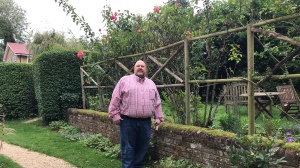
I have had the opportunity for a great deal of “meditation” this week regarding so many aspects of both my personal and professional life while serving as a Scholar in Residence at The Kilns. I use the word “meditation” here and put it in quotes purposely because it is in the title of an essay titled “Meditation in a Toolshed,” by C. S. Lewis. For this post I am using the definition of meditation from Oxford Languages of “a written or spoken discourse expressing considered thoughts on a subject” for “meditation.” I make that distinction because my own definition of meditation here has been based on the opening two paragraphs of “Meditation in a Toolshed”:
“I was standing today in the dark toolshed. The sun was shining outside and through the crack at the top of the door there came a sunbeam. From where I stood that beam of light, with the specks of dust floating in it, was the most striking thing in the place. Everything else was almost pitch-black. I was seeing the beam, not seeing things by it.
Then I moved, so that the beam fell on my eyes. Instantly the whole previous picture vanished. I saw no toolshed, and (above all) no beam. Instead I saw, framed in the irregular cranny at the top of the door, green leaves moving on the branches of a tree outside and beyond that, 90 odd million miles away, the sun. Looking along the beam, and looking at the beam are very different experiences.”
C.S. Lewis, “Meditation in a Toolshed” in God in the Dock (Grand Rapids: Eerdmans, 1998, pp. 212-215.)
And that’s just the beginning of the essay! The point Lewis was making is that instead of merely looking at the sunbeam and looking through it, out into the world beyond the dark of the toolshed, he sees a completely different picture. As he said, “Instead I saw, framed in the irregular cranny at the top of the door, green leaves moving on the branches of a tree outside and beyond that, 90 odd million miles away, the sun” (Lewis, p. 212). There is a difference between simply looking at something or experiencing it. We must use our experiences, just as Lewis used his toolshed experience to see something greater. Without this deeper meditation the experience would be lost on us. I call this being the “Deer In The Headlights.”
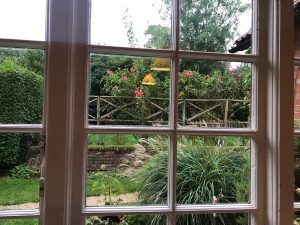
This is why it was so important for me to be at The Kilns as a Scholar in Residence. I felt the need to live through (along) this incredible place that C. S. Lewis lived, meditated, and wrote as opposed to just looking at it. I didn’t want to just see the property – that’s a tour. I wanted to see through the property – living through The Kilns. I wake each morning to see the roses outside the windows and then can go smell them. I hear the stairs creak and crack as I walk up to Lewis’ study. I will never forget the feel of the southerly breeze and warmth of the sun through the window in Lewis’ study. You get the idea.
My entire study experience has been deepened because of the full immersion into C. S. Lewis’ life. Even my walks to the local pubs and other sites gave me the opportunity live through Lewis, who was described as a habitual walker. I wanted to walk where he walked. Lewis used the simple example of the neurologist who can describe pain scientifically, but really understands it because he has looked along pain (experienced) and not just looked at pain.
Lewis explained that we can’t look at or along, but use both. He said, “…we must start with no prejudice for or against either kind of looking” (p.215). We need the entire picture from looking at and along.
leave a comment